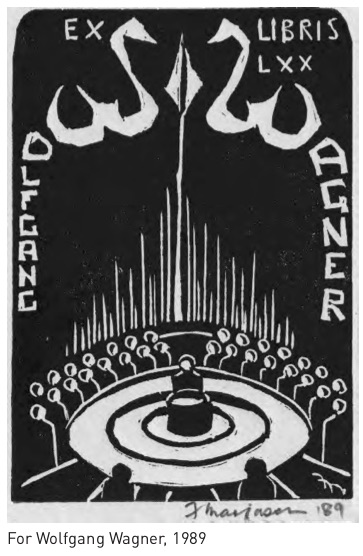By Richard King, Member no. 15
An excerpt from THE NEW AUSTRALIAN BOOKPLATE SOCIETY Newsletter No. 62, September 2021
In 1989 to mark his 70th birthday, the Wagner Society of New South Wales commissioned a bookplate for Richard Wagner’s grandson Wolfgang Wagner (1919-2010) from Sydney printmaker Frank Marjason (1914-2011). I had known the artist’s mother when I was young; Gladys Marjason was also an exceptional artist in her own right. In the 1950s she was a great mentor to me, opening doors to the art world and artists of Sydney, and no doubt laying the foundations for my own journey into music and the arts. Frank was at that time a teacher of printmaking and drawing at Willoughby Workshop Arts Centre on Sydney’s lower North Shore.
Along with the late Dr Leonard Hansen, we had conceived of the idea of forming a Wagner Society in Sydney to encourage the performance of his ‘music dramas,’ as Wagner called them, and to assist aspiring young singers to further their careers with scholarships. The first ever meeting of the Society was convened in 1980 by Leonard in Bayreuth, with fellow attendees of the Festival ... so many people with great enthusiasm ensured its success over the following years. Every year after that date there was always a group of Aussies who had made their pilgrimage to Bayreuth.
Through the organization, The Friends of Bayreuth, meetings with the Wagner family were arranged and we were regular guests to backstage tours and a private dinner with Wolfgang and his wife Gudrun, in the small dining room of the Festspiel house. There were always only about six or eight of us which enabled us to have detailed conversations with Wolfgang who often was the director of one of the productions.
During one of our committee meetings in 1989 the idea of a special gift to mark Wolfgang’s 70th birthday was on the agenda, and I suggested a bookplate because it is such a personal item and something we felt sure no one else would have thought of. So it was agreed, and I suggested Frank be commissioned. The design was left to Frank and he came up with the Parsifal motif along with incorporating the W in capitals which also transforms into the swan, a feature of the opera Lohengrin. All were delighted with the concept.

Frank Marjason’s art training had begun in early 1930s with a year of night drawing classes at East Sydney Technical College as he was employed by the Commonwealth Bank where he remained for the rest of his working life, interrupted by service during 2nd world war. In the 1960s he studied, also at night, with Louis Kahan in Melbourne and later in Canberra with Tom Gleghorn and John Coburn. He retired from the Bank in 1974 and continued painting whilst exploring various graphic arts, and in 1986 was introduced by Ruth Burgess to the woodcut and linocut. Frank said that the linocut immediately appealed to him because of its ‘speed, simplification of the subject, directness and predictability.’
Later on in that year we commissioned another bookplate for the growing reference library the Wagner Society was creating. Around that time I saw an article about the people who had the greatest number of books written about them in all languages the world over. Christ Jesus had by far the greatest number followed by Napoleon and third was Richard Wagner, with over twenty-three thousand! The astonishing thing is, about six to ten new books are written and published about Richard Wagner, the man and or his works, each year. What can be said in these new books that has not already been said in twenty- three thousand others?

I had commissioned a bookplate for my own books from Frank in 1987, again leaving him to create the design. His depiction of the hand using the fine knife to carve out the image must be unique, I think, in the world of the bookplate. Instead of using my surname, King, he substituted a crown – a man of great humour indeed!

All the bookplates were hand printed by the artist in editions of fifty prints. We gave Wolfgang the original linocut block in case he should need to print more for his library. (Note: a photo of the handover was in Quarterly No 18, Sept 2020)
I am sure, from memory, that Frank also created bookplates for friends and family. Research for someone in the future. Frank died in 2011 in his mid-nineties, still active until the day he died.
Editor’s Note: Richard King has very generously donated to the Wagner Society and given copies of the original linocuts to the Bookplate Society.
From Wagner Quarterly 163, December 2021
